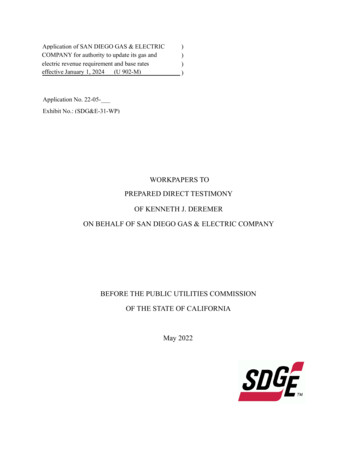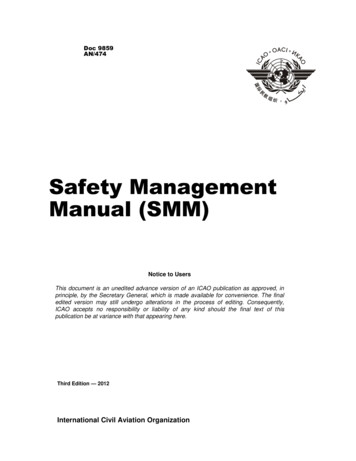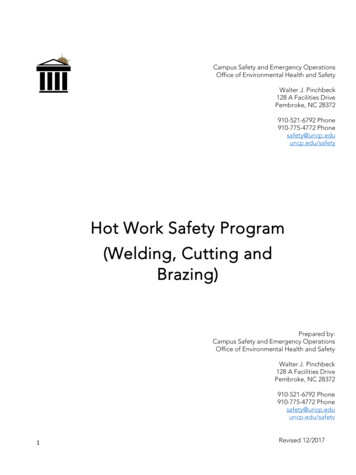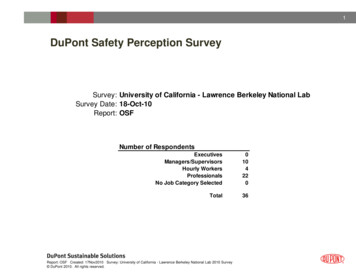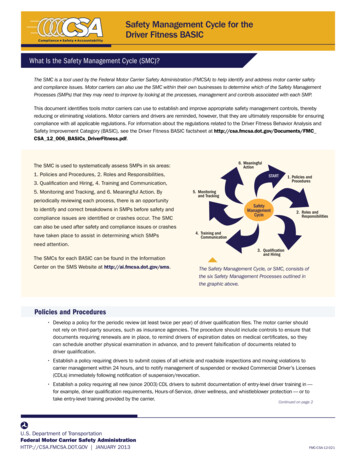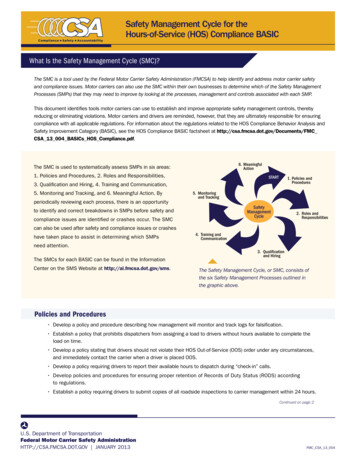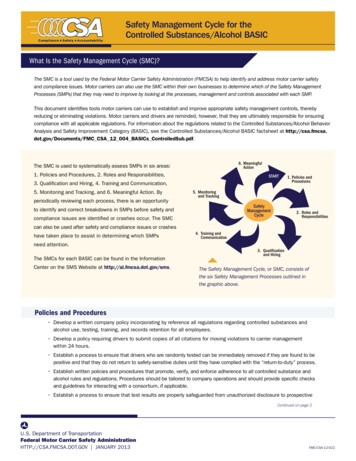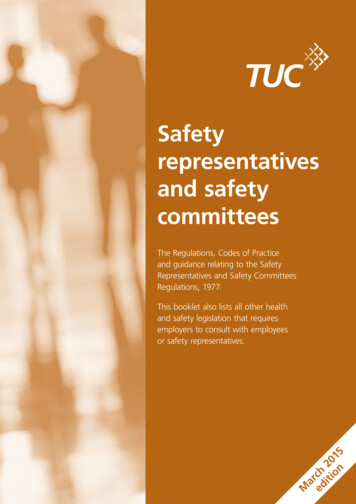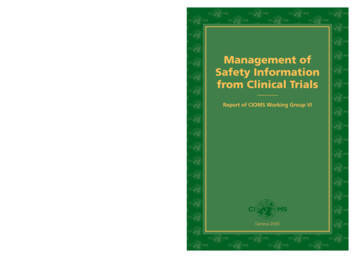
Transcription
CIOMSBoth CIOMS and WHO publications are distributed by theWorld Health Organization, Marketing and Dissemination,Avenue Appia, 1211 Geneva 27, Switzerland and are availablefrom booksellers through the network of WHO sales agents.A list of these agents may be obtained from WHO by writingto the above address.Price: CHF 40.–GROUP6 COVER DEF.indd 1Management of Safety Information from Clinical TrialsCIOMS publications may be obtained directly from CIOMS,c/o World Health Organization, Avenue Appia, 1211 Geneva 27,Switzerland or by e-mail to cioms@who.intManagement ofSafety Informationfrom Clinical TrialsReport of CIOMS Working Group VIGeneva 20057.8.2007 12:17:50
Management ofSafety Informationfrom Clinical TrialsReport of CIOMS Working Group VIGeneva 2005group6 PH.indd 17.8.2007 12:19:13
Copyright 2005 by the Council for InternationalOrganizations of Medical Sciences (CIOMS)ISBN 92 9036 079 8group6 PH.indd 27.8.2007 12:19:15
AcknowledgementsThe Council for International Organizations of Medical Sciences (CIOMS)gratefully acknowledges the contributions of the members of CIOMSWorking Group VI on the Management of Safety Information from ClinicalTrials as well as the drug regulatory authorities, pharmaceutical companiesand other organizations and institutions which supported the work thatresulted in this publication. Hard work, drafting and redrafting of papers,their reviews and a number of debates in the Working Group requiredpatience, motivation and active collaboration from all members.CIOMS acknowledges especially the co-chairs, Drs. Wendy Stephensonand Gottfried Kreutz, for their capable leadership, and Ms Linda Hostelley,the secretary of the group. The editorial group, comprised of Drs. Gerald DalPan, Arnold J. Gordon, Marianne Keisu, Siddika Mithani, and WendyStephenson, merits special mention and thanks. CIOMS also wishes toexpress special appreciation to Dr. Gordon, who as chief editor of the finalreport assured the quality of the publication.CIOMS and the Working Group are thankful for important inputreceived on several topics from many senior experts outside the Group whoreviewed the entire manuscript and made valuable suggestions: Drs. Ric Day(University of South Wales, Australia), Frank Rockhold and Rita Patwardhan(GlaxoSmithKline, US), and Patrick Waller (Consultant, UK). Members of theUS and EU pharmaceutical industry associations (PhRMA and EFPIA) alsoprovided very helpful detailed comments and suggestions; special thanksare due to Drs. Barry Arnold (AstraZeneca, UK) and Brian Edwards (BarnettParexel, UK) and to Cindy Engle (GlaxoSmithKline, US) for their roles in synthesizing these contributions. Dr. Susan Ellenberg (FDA, US) contributed herexpertise to material covering Data and Safety Monitoring Boards. Dr. SusanSacks (F. Hoffmann-La Roche Ltd.) provided key information on sources of3group6 PH.indd 37.8.2007 12:19:15
epidemiological and related databases. Thanks are also due to a number ofcolleagues from pharmaceutical companies who completed the CIOMS VIquestionnaire (see Appendix 3). Finally, we are grateful to Meghan McLaren(Health Canada) for her administrative assistance in preparing the draft andfinal documents.Geneva, April 2005Juhana E.Idänpään-Heikkilä, MD. PhDSecretary-General, CIOMS4group6 PH.indd 47.8.2007 12:19:15
DedicationThis work is dedicated to the many thousands of patients and othervolunteers who generously participate in clinical research programs sovital for the development and advancement of medicines.5group6 PH.indd 57.8.2007 12:19:16
group6 PH.indd 67.8.2007 12:19:16
Table of ContentsPageVISION .13PREFACE .15IINTRODUCTION AND OVERVIEW .19a.Rationale for the CIOMS VI Project .21b.Results of the CIOMS VI Survey on Company Practices .25c.Areas Covered by the CIOMS VI Project .26 Terminology and definitions .27 Ethical aspects of clinical trials .27 Overall pharmacovigilance/risk management system .27 Collection and proper management of safety data .28 Evaluation of safety data .28 Statistical analysis of safety data .29 Regulatory reporting and communication to othersIIof safety information during clinical trials .29d. Limitations of Clinical Trials for Understanding Safety .30e. Scope of the Project .32ETHICAL CONSIDERATIONS FOR CLINICAL TRIALSAFETY MANAGEMENT.35a. Background .37b. The Stakeholders .39 Patients .39 Regulatory Authorities and the Public Health Community .40 Investigators .41 IECs and IRBs .41 Data and Safety Monitoring Boards .43 Pharmaceutical Companies and Their Representatives .447group6 PH.indd 77.8.2007 12:19:16
IIIc. Evolving Regulatory and Societal Demands .44 Privacy and Confidentiality of Personal Data.45 Informed Consent .46 Transparency in Availability of Clinical Trial Results.47 Other Issues .51GOOD PHARMACOVIGILANCE AND RISK MANAGEMENTPRACTICES: SYSTEMATIC APPROACH TO MANAGINGSAFETY DURING CLINICAL DEVELOPMENT .53a. Introduction .55b. Principles of a Systematic Approach .57 Begin early .57 Establish a procedure .57 Establish a Multidisciplinary Safety ManagementTeam (SMT) .58 Establish a project management function.59 Determine background data .60 Ensure accessibility of data .60 Develop a proactive approach .60 Establish timeframes and milestones .61 Decision making .62 Advisory bodies .62c. Components of a Development Risk Management Plan (DRMP) .63d. Role of Epidemiology.67e. Specific Issues that Should Always be Considered .70 Cardiac electrophysiology .70 Hepatotoxicity .71 Drug-Drug and Food-Drug interactions .71 Immunogenicity.71 Bone marrow toxicity .72 Potential for reactive metabolite formationand hypersensitivity .72f. Conclusion .728group6 PH.indd 87.8.2007 12:19:16
IVCOLLECTION AND MANAGEMENT OF SAFETY DATADURING CLINICAL TRIALS .75a. Introduction .77b. Who? .79c. What?.81 General Principles .81 Causality Assessment .84 Diagnoses vs Signs and Symptoms .86 Adverse Events of Special Interest .88 Laboratory Chemistry Measurements .88 Morbidity and Mortality as Efficacy Endpoints .89 Special Situations .90d. How?.91 General Considerations .91 Serious and Other Important Adverse Events .94e. When? .95f. Safety Data Management Considerations .97 Clinical Description of Adverse Events .98 Coding Procedures . 101 Dealing with Unblinded Data . 103 Data Processing Issues . 104VIDENTIFICATION AND EVALUATION OF RISKFROM CLINICAL TRIAL DATA . 107a. Introduction . 109b. Expectations and Limitations in the Identificationand Evaluation of Safety Information from Clinical Trials . 111c. Points to Consider During Analysis and Evaluation ofSafety Information. 114 Patient Population Characteristics, Including NaturalHistory of Disease . 114 Current Therapeutic Standards . 115d. Timing of Safety Evaluation. 1169group6 PH.indd 97.8.2007 12:19:16
e. Safety-Signal Detection and Evaluation . 117f. Consistent Causality Assessment – Adverse Events vs AdverseDrug Reactions . 119g. Important Types of Analyses . 120h. Review of Individual Cases . 121i.Considerations for Periodic Review and Evaluationof Case Reports in Aggregate . 122j.Pooling of Data . 123k. Evaluation of Clinical Laboratory Data . 124l.General Benefit-Risk Considerations . 127m. Aggregate Analysis and the DCSI . 127VISTATISTICAL ANALYSIS OF SAFETY DATAIN CLINICAL TRIALS . 129a. Introduction . 131b. Uses of Statistics for Clinical Safety Data . 133c. Principle of Intention to Treat. 136d. Some Key Problems in Safety Analyses . 137e. Useful Approaches to Statistical Analysis of ContinuousMeasurements: Laboratory Chemistries. 139f. Statistical Treatment of Binary Data . 142 Power Considerations . 142 One-Sided vs Two-Sided Testing . 143 The Consequences of Multiplicity . 144 General Measures Using Binary Data . 145 Confidence Intervals . 148 Accounting for Time on or off Treatment . 150 Statistical Tests Using Time Since Start of Treatment. 155g. Combining Data from Several Trials: The Roleof Meta-analytical Techniques . 157h. Analysis of Rare Events . 160i.Measuring and Expressing Effects in Ways Relevantto Public Health . 16110group6 PH.indd 107.8.2007 12:19:16
j.Comments on ICH Guidelines E3 and E9: Discussion ofStatistical Aspects of Clinical Safety Data . 163VIIREGULATORY REPORTING AND OTHER COMMUNICATIONOF SAFETY INFORMATION FROM CLINICAL TRIALS . 165a. Introduction . 167b. Expedited Reporting from Clinical Trials . 169 Expedited Reporting to Regulatory Authorities . 169 Expedited Reporting: Causality . 170 Expedited Reporting: Expectedness . 171 Expedited Reporting: Unblinding . 172 Expedited Reporting: Comparators . 173 Expedited Reporting: Spontaneous Reports . 175 Prompt Reporting Other than Case Reports . 175 Expedited Reporting: Investigators and IECs/IRBs . 177c. Periodic Communication of Safety Informationfrom Clinical Trials. 180 Development Safety Update Report (DSUR) . 180 Investigator Brochure and DCSI Updates . 181 Other Periodic and Ad Hoc Communicationsto Investigators and IECs/IRBs . 182 Safety Management Process. 184d. Other Reporting Considerations . 184e. Informed Consent . 185f. Other Communication Considerations . 187g. Conclusion . 188VIII SUMMARY OF CONCEPTS AND PROPOSALS. 189APPENDICES . 2171. Glossary and Abbreviations. 2172. Membership and Process of CIOMS Working Group VI . 2413. CIOMS VI Working Group Survey of PharmaceuticalCompany Safety-Management Practices During Clinical Trials . 24511group6 PH.indd 117.8.2007 12:19:17
4. World Medical Association Declaration of Helsinki . 2595. Data and Safety Monitoring Boards (DSMBs) . 2656. Data Elements that Should Be Considered for IndividualAdverse Event Reports . 2717. Causality Criteria and Threshold Considerations for Inclusionof Safety Data in Development Core Safety Information (DCSI) . 2758. Sample Serious AE Report Data Collection Formfor Investigators . 2799. Databases for Epidemiology and Pharmacoepidemiology . 287INDEX . 28912group6 PH.indd 127.8.2007 12:19:17
VisionPatients and prescribers expect approved medicines to be “safe andeffective.” The goal of those who produce and regulate proprietary medicinal products is to ensure that this expectation is met. This requires thatclinical trials be planned and performed to provide good evidence thattested medicines are effective and that patients can be reassured that thebenefits outweigh the risks, both during the development process and ingeneral use.This report has implications for all stakeholders in clinical medicinalresearch:1)2)3)4)5)6)patients and other volunteersinvestigators and their site staffethics review committeesdata and safety monitoring boardsdrug regulatory authorities and the public health communitypharmaceutical companies and other clinical research sponsorsThe vision of the CIOMS VI Working Group is that this report willenhance awareness of the ethical and technical issues associated with safetyin clinical trials and point out the need for increased care and scrutiny inthe conduct of research. It is also hoped that this work will advance the methodology for collecting, analysing, evaluating and reporting informationon product safety ascertained in clinical trials, and help to set standards inthese areas. Establishing and maintaining standards by all involved groupswill benefit all participants in trials and improve public health for those whotake medicines.Pharmacovigilance has traditionally focused on detection and evaluation of signals in the post-approval environment in order to secure earlydetection of new adverse reactions or patient subgroups of exceptional sensitivity, and to introduce measures to manage those risks.However, we believe that there is a need not only to incorporate newerapproaches for managing safety information in the clinical trial setting, butalso to adapt the methods and tools used in post-approval pharmacovigilance to the early and late stages of pre-approval development of medicinalproducts. It is our vision that the practical approaches providedin this report will aid these processes and will enable a more seamless13group6 PH.indd 137.8.2007 12:19:17
transition in conducting high quality pharmacovigilance from the development stage to the post-approval period. We also hope that this work willstimulate research in several unresolved areas.Finally, we recognize that new regulations have recently been enactedin the EU and are pending elsewhere, such as in the US. It is hoped thatthis book will stimulate the regulators to reconsider aspects of regulationspertaining to our proposals; we believe that our suggestions can help toimprove the ability to generate and analyze useful safety data and to protecttrial participants.14group6 PH.indd 147.8.2007 12:19:17
PrefaceSince 1986, when they began a series of projects dedicated to important drug safety issues, the CIOMS Working Groups on drug safetyhave been recognized for creating the theoretical platforms and pragmaticsuggestions to advance the debates leading to harmonization of international pharmacovigilance practices. The initiatives over the years, identified as CIOMS Working Groups I, IA, II, III, IV and V, have resultedin six major published reports.1 The nature of their membership, seniordrug safety officials from many major regulatory agencies and the regulated pharmaceutical industry, and their modus operandi as a “think tank”seeking practical solutions to important problems, have facilitated theirunique contributions. All members have served less as representatives ofany single organization or interest and more as motivated colleagues, withday-to-day responsibility in the drug safety field. All shared a commitment to think beyond their local practices even if such thinking were indisagreement with current rules and regulations, in order to optimize drugsafety procedures, particularly in an international context. Although theWorking Groups did not – indeed could not – develop regulations, its workhas always been intended to inform and encourage those with rulemaking responsibilities. Gratifyingly, many of the recommendations havebeen incorporated into regulations, not only in the countries of the participating regulators, but elsewhere as well.The CIOMS I Working Group introduced definitions, criteria and astandard form (CIOMS I Form) for international reporting of medicallyimportant (“serious”) adverse drug reactions (ADRs) to marketed products. It also served as a model for the development of the InternationalConference on Harmonization (ICH) Guideline E2A on expedited ADRcase reporting for clinical trials.The result of the CIOMS II deliberations was a set of proposedstandards for the format, content and frequency of periodic safety updatereports (PSURs) which has been adopted by many regulatory authorities.1International Reporting of Adverse Drug Reactions (CIOMS I) (1990); International Reporting of PeriodicDrug-Safety Update Summaries (CIOMS II)(1992); Guidelines for Preparing Core Clinical-Safety Information on Drugs, First Edition (1995) (CIOMS III) and Second Edition, Including New Proposals for Investigator’s Brochures (1999)(CIOMS III/V); Benefit-Risk Balance for Marketed Drugs: Evaluating Safety Signals(CIOMS IV)(1998); Current Challenges in Pharmacovigilance: Pragmatic Approaches (CIOMS V)(2001).All published by the Council for International Organizations of Medical Sciences, Geneva.15group6 PH.indd 157.8.2007 12:19:17
It also formed the basis for the ICH Guideline on periodic reporting, E2C,2adopted in 1996 and subsequently implemented internationally. A recentlyadopted addendum to ICH E2C3 represents further refinement of the harmonization concepts espoused by the CIOMS V Working Group.Coincident with CIOMS II and in recognition of the need for more efficient, automated techniques to document and report ADRs to regulators,the CIOMS IA subgroup worked on a proposal for a harmonized format forelectronic submissions. The CIOMS IA recommendations were not published but formed the basis for the ICH Guideline E2B (Data Elements forTransmission of Individual Case Safety Reports, 1997).The CIOMS III Working Group concentrated on best practices for applying the concept of “company core safety information” (CCSI) introduced in CIOMS II. The Working Group developed a set of what have conveniently been referred to as “good safety information/labeling practices”for post-approval drug safety data, including practical guidance on determining when the threshold has been reached for adding an adverse reactionto the CCSI. In the CIOMS III/V report, the second edition of the CIOMSIII report, the concepts were extended to the pre-approval environment byrecommending use of Development Core Safety Information (DCSI).One of the most important aspects of post-marketing safety surveillance is the identification and analysis of new, medically important findings that might influence the use of a medicine. In recognizing that thereexisted at the time no guidance on a systematic approach for handling theemergence of a major safety issue, especially one that might lead to important regulatory action, CIOMS IV developed its proposals for approachesto comparative benefit-risk evaluation, analysis of options for action, andgood decision making practices.As acknowledged in the reports by each of the Working Groups, unresolved and un-addressed issues remained. Thus was born the CIOMS VWorking Group which focused on several difficult aspects of day-to-daypharmacovigilance work that affect the management and interpretation ofsafety data. The proposals and their rationale are the subject of the CIOMSV report which has become a regular source of guidance to industry professionals engaged in the day-to-day management of safety reporting.2ICH E2C Clinical Safety Data Management: Periodic Safety Update Reports for Marketed Drugs, Step 5 asof November 1996. (See http://www.ich.org)3Addendum to ICH E2C: Periodic Safety Update Reports for Marketed Drugs, Step 5 as of February 2003.(See http://www.ich.org)16group6 PH.indd 167.8.2007 12:19:18
Proposals emanating from CIOMS Working Groups I through Vwere principally focused on post-marketing surveillance regulations andactivities. These are described in greater detail in published papers.4,5 TheCIOMS Working Group reports themselves can be ordered by sending arequest to cioms@who.ch.The current report, that of the CIOMS VI Working Group, represents a shift from the management of post-marketing safety information,which relies heavily on spontaneous reports, to the management of clinical trial information, starting from the earliest clinical trials and extendingto the post-marketing environment. The CIOMS VI Working Group alsorepresents an expansion in membership to include regulatory, industry andacademic representation with experience in the conduct of clinical trialsand to include representatives from less developed regions of the world.This book introduces proposals for enhancing the collection, analysis, evaluation, reporting and overall management of safety information from clinical trials. It also discusses the importance of sponsors’ having a systematicapproach to managing risk during development, taking into account nonclinical as well as clinical data. CIOMS VI is not intended to be a reiteration of other available guidances and guidelines on these subjects 6,7,8,9,10or a rehash of closely related recent work.11,12 Rather, the proposals in thisdocument should be considered along with the principles established inthose authoritative documents.The views and recommendations in this book are those of theCIOMS VI Working Group as a whole, generally reached through a consensus process, or in some cases by a majority vote. They do not necessarilyrepresent the views of the participants’ sponsoring organizations.4Castle, W. Overview of the CIOMS Pharmacovigilance Working Group. Regulatory Affairs Focus, April 2000(Regulatory Affairs Professionals Society; see www.raps.org)5Tsintis, P. and LaMache, E. CIOMS and ICH Initiatives in Pharmacovigilance and Risk Management.Overview and Implications. Drug Safety, 27 (8):509-517, 20046ICH E6 Good Clinical Practice: Consolidated Guideline, Step 5 as of May 1996. http://www.ich.org7ICH E9 Statistical Principles for Clinical Trials, Step 5 as of February 1998. http://www.ich.org8ICH E3 Structure and Content of Clinical Study Reports, Step 5 as of November 1995. http://www.ich.org9ICH E2A Clinical Safety Data Management : Definitions and Standards for Expedited Reporting, Step 5 asof October 1994. http://www.ich.org10Guideline for the Format and Content of the Clinical and Statistical Section of an Application, US FDACenter for Drug Evaluation and Research, July 1988. http://www.fda.gov/cder/guidance11Guidance for Industry: Good Pharmacovigilance Practices and Pharmacoepidemiologic Assessment, andPremarketing Risk Assessment. US Food and Drug Administration, March 2005. (See http://www.fda.gov/cder/guidance/6357fnl.htm and http://www/fda.gov/cder/guidance/6359OCC.htm), respectively.12ICH Guideline E2E. Pharmacovigilance Planning (PvP), Step 4 as of November 2004. (See http://www.ich.org)17group6 PH.indd 177.8.2007 12:19:18
It is recognized that some of the proposals, in particular those found inChapter 7, may be in conflict with existing regulations in various countriesand in newly enacted legislation in Europe. However, it is the hope of theCIOMS VI Working Group that its recommendations may stimulate regulators to rethink some aspects of their regulations in terms of the practicalityof implementation and the usefulness of the safety information provided tostakeholders. This book is primarily aimed at providing guidance to sponsors of clinical trials. The hope is that these proposals, once adopted byregulatory authorities, will enhance our ability to protect patient well-beingand optimize the development and use of new medicines.18group6 PH.indd 187.8.2007 12:19:19
IIntroductionand Overviewgroup6 PH.indd 197.8.2007 12:19:19
group6 PH.indd 207.8.2007 12:19:19
a. Rationale for the CIOMS VI ProjectMedical research on human subjects is capable of providing significant advances to benefit individuals and public health. The universallyaccepted motif for such endeavors is that all such research be designedto create important scientific knowledge, that it maximize the potentialbenefits to the subjects, and, most importantly, it minimize their risks.Thus, although this report focuses on the technical, medical and regulatory aspects of “drug safety” during clinical research, the foundation forall these activities must always be the respect for the rights and welfareof clinical trial participants. Some harm to individual patients or subjectsmay be considered tolerable – for after all, it is the proper balance betweenbenefits and risks that drives not only the research process but the use ofany marketed medicine.1,2Regu
from Clinical Trials Report of CIOMS Working Group VI Geneva 2005 CIOMS Management of Safety Information from Clinical Trials CIOMS publications may be obtained directly from CIOMS, c/o World Health Organization, Avenue Appia, 1211 Geneva 27, Switzerland or by e-mail to cioms@who.int Both CIOMS and WHO publications are distributed by the



